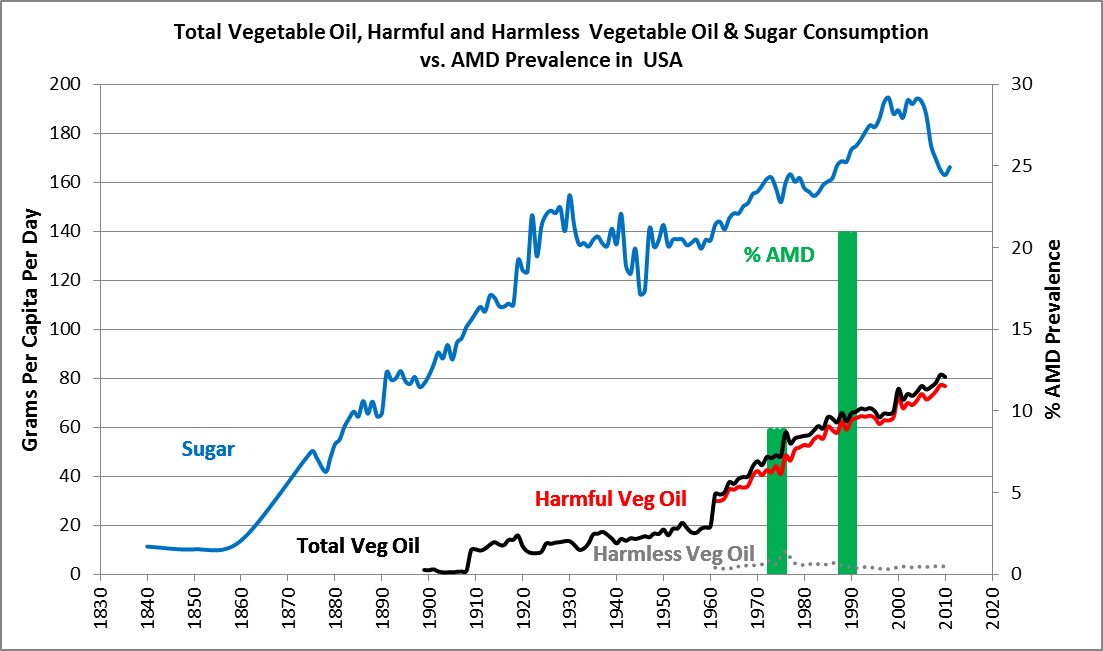The AREDS 2 trial sought to determine whether the addition of the carotenoids, lutein and zeaxanthin, or the long-chain omega-3 fatty acids, EPA and DHA, or both, might further reduce the progression of age-related macular degeneration AMD. In the authors’ own words, “Addition of lutein + zeaxanthin, DHA + EPA, or both to the AREDS formulation in primary analyses did not further reduce risk of progression to advanced AMD.” 39
So the AREDS formula supplement appeared to benefit, in people with moderate AMD in both eyes or advanced AMD in one eye, one out of 12 subjects who took the supplements for 5 years, at least according to this one trial.
Recall that the other 12 trials, all of which were shorter in duration, found no benefit to the supplements. So we ophthalmologists generally recommended the “AREDS vitamins.”
But then ophthalmologist Carl Awh, M.D., and colleagues, assessed the AREDS results based on genetic profiles. They determined that those people with certain genetic profiles (high CFH and low ARMS2), which was 13% of the studied population, had a 135% higher chance of progressing to advanced stages of AMD – if they took the AREDS supplements.40,41 This is a more than doubling of the rate of progression – apparently caused by taking the supplements. Now what?
AMD Prevalence Versus a Westernized Diet – Original Research
To evaluate the effect of Westernization on diet versus the development and prevalence of AMD, my colleague, Marija Stojanoska, MSc, and I mined the two greatest proxy markers of processed food, sugar, and vegetable oils – from the Food and Agricultural Organization of the United Nations (FAO) databases. We then plotted that data against AMD prevalence in 25 nations. Click here to reference all of the graphs and data below in our published paper.
In this article, three representative graphs for three nations will be presented. Note that we’ve separated vegetable oils into “Harmless Vegetable Oils,” which are saturated oils (coconut, palm, and palm kernel oils, plus olive oil and flaxseed oil), and the “Harmful Oils,” which are the oils containing the most polyunsaturated oils (soybean, corn, canola, cottonseed, sunflower, safflower, rapeseed, grapeseed, and rice bran oils). Those oils deemed to be of intermediate risk, due to the presence of both polyunsaturated and monounsaturated components, included peanut, sesame, and high oleic sunflower and high oleic safflower oils, were categorized among the “harmful oils,” however, their proportions are relatively very small in most Western cultures, and there is significant evidence that peanut and sesame oils are far safer, having been consumed by Asian cultures with an apparent high degree of tolerance for many decades.
Below is the correlative data for sugar and vegetable oils versus AMD prevalence, in the U.S.:
Note that total vegetable oil consumption was around two grams a day from 1900 until about 1909 and then jumped up to 10g/person/day and climbed from that point forward, eventually reaching 80g/person/day by 2010. Sugar consumption was already at about 80 grams per day by 1900, climbing to a high of nearly 200g/day by 1999. As you will recall, age-related macular degeneration AMD prevalence was negligible from 1851 until the 1930s and as one can see from the graph, was at epidemic proportions by the 1970s and beyond.

Japan is perhaps one of the greatest examples where we see Westernization of the diet in just the past five decades and, within a period of just under 30 years, we see the rise of age-related macular degeneration AMD from the status of an extreme medical rarity to epidemic proportions. Note that the “Harmful Vegetable Oils” elevated from 1961 forward, rising 4.5-fold between 1961 and 2005. Sugar consumption rose from approximately 50 grams per day in 1961, to over 90 grams a day by the late 1960s and remained nearly at that level through 2011. Westernization of Japan’s diet was associated with an increase in AMD prevalence from 0.2% between 1974 and 1979 to 11.4% by 2007, an increase of 57-fold in the prevalence of AMD in a period of no more than 30 years!
Ask yourself, “How could a 57-fold increase in AMD prevalence in a period of 30 years be explained by aging and genetics?”

In the Solomon Islands, we see that sugar consumption, from 1961 forward, remains extremely low at around 20 grams per day, while harmful vegetable oil consumption remains at almost negligible levels from 1961 forward. And the prevalence of AMD is approximately 0.2% — that is, almost non-existent for the past ten years. The situation is almost identical in Samoa, while sugar consumption is much higher in Kiribati, age-related macular degeneration AMD prevalence remains a medical rarity.
Conclusions and Dietary Recommendations
We’ve seen that, historically, macular degeneration was an extreme medical rarity from 1851 until the 1930s. During that era, three of our four major nutrient-deficient processed food elements were introduced – refined white flour in 1880, polyunsaturated vegetable oils just after the American Civil War ending in 1865, and trans-fats in 1911. Sugar consumption, our fourth nutrient-deficient processed food, was on the rise. By the 1930s, macular degeneration was on the radar of ophthalmologists as a significant entity. By the 1970s, AMD was at epidemic proportions in the U.S. and U.K., with many nations subsequently following suit.
Every shred of evidence that I can find supports the hypothesis that it is the ‘displacing foods of modern commerce’ that are the primary and proximate cause of AMD.
The prevention of this disease – as well as the treatment – is to remove those elements from the diet that truly make it “Westernized,” i.e., refined (added sugars), refined white flours, vegetable oils, and trans fats, and, instead, consume only elements of our traditions, i.e., our own native, traditional diets, whatever one chooses for that to be.
This means eliminating man-made, processed, nutrient-deficient, and toxic food components.
This would mean, generally, that one should consume a diet rich in 100% pasture-raised meats (beef, lamb, chicken), wild-caught fish, pastured eggs, possibly fruit and vegetables (if well tolerated, and organic if possible), possibly very small amounts of nuts and seeds, and critically, some “sacred” foods of our ancestors, such as beef or chicken liver, fish eggs (roe), and/or extra virgin cod liver oil (EVCLO) and very likely, pastured, grass-fed butter, and/or raw, grass-fed whole milk. These so-called “sacred foods” are rich in the fat-soluble vitamins, A, D, and K2, which are not well-distributed in the food supply, but are incredibly and vitally important to preventing degenerative disease. Please note, age-related macular degeneration, as its name implies, is a degenerative disease.
My preference and recommendation is to choose the wild or pastured versions of animal meats and eggs whenever possible, and organic versions of grains, fruits, and vegetables, if affordable. However, even the concentrated animal feeding operation (CAFO) raised versions of these animals and non-organically raised fruits and vegetables will be markedly superior for health as compared to man-made, processed, nutrient-deficient foods, such as most fast-foods and prepared and packaged foods.
As for the AREDS formula vitamins, I advise against them, in favor of an ancestral diet.
Finally, in my humble opinion, macular degeneration should no longer be called ‘age-related macular degeneration’ (AMD), but rather, Diet-Related Macular Degeneration (DMD), as we have recommended in our hypothesis introducing paper, published in the November issue of the highly regarded journal, Medical Hypotheses.
Chris A. Knobbe, MD, is an ophthalmologist and Associate Clinical Professor Emeritus, University of Texas Southwestern Medical Center, in Dallas, Texas, as well as the Founder and President of Cure AMD Foundation™. Dr. Knobbe is the author of the book, Ancestral Dietary Strategy to Prevent & Treat Macular Degeneration, which is available at this link. Dr. Knobbe may be reached directly via the contact form at CureAMD.org.
References
See the full list of references here.
__________________________________
This is Part Three of a three-part series.
Find Part One here: Understanding Blindness – AMD Signs, Symptoms, and Diagnosis
Find Part Two here: The Blindness Epidemic in the 19th & 20th Centuries
.

